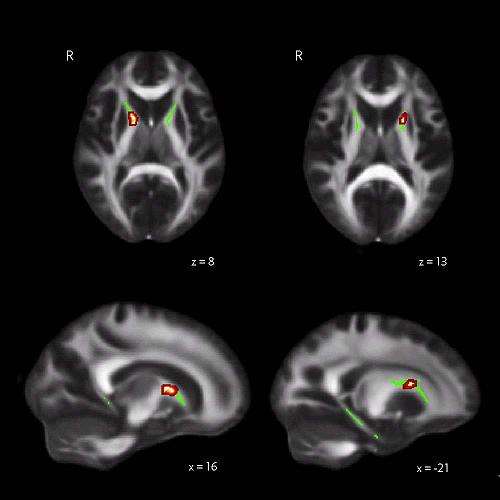Diffusion tensor image showing the white matter in the brains of bad navigators. The red colour indicates extra white matter around the caudate nucleus.
The brains of people who immediately know their way after travelling along as a passenger are different from the brains of people who always need a GPS system or a map to get from one place to another. This was demonstrated by Joost Wegman, who will defend his thesis at Radboud University Nijmegen, the Netherlands on the 27th of November.
Wegman demonstrates that good navigators store relevant landmarks automatically on their way. Bad navigators on the other hand, often follow a fixed procedure or route (such as: turn left twice, then turn right at the statue).
Anatomical differences
Wegman also found that there are detectable structural differences between the brains of good and bad navigators. 'These anatomical differences are not huge, but we found them significant enough, because we had a lot of data', the researcher explains. 'The difference is in the hippocampus. We saw that good navigators had more so-called gray matter. In the brain's gray matter information is processed. Bad navigators, on the other hand, have more white matter – which connects gray matter areas with each other – in a brain area called the caudate nucleus. This area stores spatial actions with respect to oneself. For example, to turn right at the record store', Wegman describes.
Questionnaires
For his research, Wegman combined data from several studies done by the Radboud University research group Neural Correlates of Spatial Memory at the Donders Institute for Brain, Cognition and Behaviour.
Wegman: 'We always give participants extensive questionnaires in our studies. This allows us to explain possible differences in behaviour afterwards. People generally have a good insight into their ability to find their way, so these questions provide a feasible way to assess these abilities. I have coupled the answers of these questionnaires with the brain scans we have collected over the years, which allowed us to detect these differences'.
More information: Wegman, J. & Janzen, G. "Neural encoding of objects relevant for navigation and resting state correlations with navigational ability." Journal of Cognitive Neuroscience 23, 3841–3854 (2011).
Wegman, J. et al. "Gray and white matter correlates of navigational ability in humans." Human Brain Mapping (in press). DOI: 10.1002/hbm.22349
Journal information: Journal of Cognitive Neuroscience , Human Brain Mapping
Provided by Radboud University Nijmegen



















